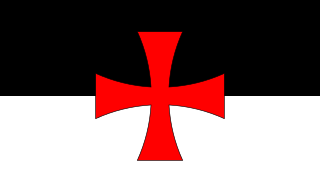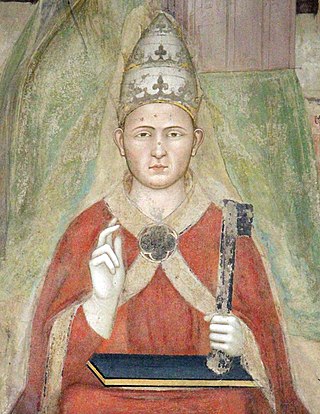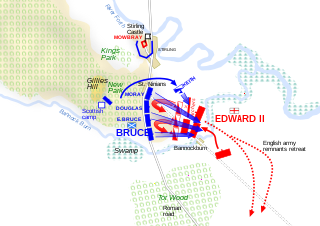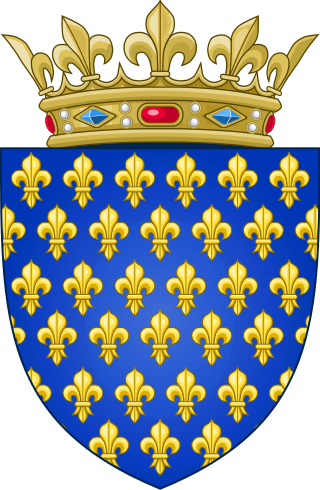Related Research Articles

The Poor Fellow-Soldiers of Christ and of the Temple of Solomon, mainly known as the Knights Templar, was a French military order of the Catholic faith, and one of the wealthiest and most popular military orders in Western Christianity. They were founded 1118 to defend pilgrims on their way to Jerusalem, with their headquarters located there on the Temple Mount, and existed for nearly two centuries during the Middle Ages.

Pope Clement V, born Raymond Bertrand de Got, was head of the Catholic Church and ruler of the Papal States from 5 June 1305 to his death, in April 1314. He is remembered for suppressing the order of the Knights Templar and allowing the execution of many of its members. A Frenchman by birth, Clement moved the Papacy from Rome to Avignon, ushering in the period known as the Avignon Papacy.

Year 1310 (MCCCX) was a common year starting on Thursday of the Julian calendar.

1314 (MCCCXIV) was a common year starting on Tuesday of the Julian calendar, the 1314th year of the Common Era (CE) and Anno Domini (AD) designations, the 314th year of the 2nd millennium, the 14th year of the 14th century, and the 5th year of the 1310s decade. As of the start of 1314, the Gregorian calendar was 8 days ahead of the Julian calendar, which was the dominant calendar of the time.

Philip IV, called Philip the Fair, was King of France from 1285 to 1314. By virtue of his marriage with Joan I of Navarre, he was also King of Navarre and Count of Champagne as Philip I from 1284 to 1305. Although Philip was known to be handsome, hence the epithet le Bel, his rigid, autocratic, imposing, and inflexible personality gained him other nicknames, such as the Iron King. His fierce opponent Bernard Saisset, bishop of Pamiers, said of him: "He is neither man nor beast. He is a statue."

Jacques de Molay, also spelled "Molai", was the 23rd and last grand master of the Knights Templar, leading the order sometime before 20 April 1292 until it was dissolved by order of Pope Clement V in 1312. Though little is known of his actual life and deeds except for his last years as Grand Master, he is one of the best known Templars.

The Council of Vienne was the fifteenth ecumenical council of the Catholic Church and met between 1311 and 1312 in Vienne, France. This occurred during the Avignon Papacy and was the only ecumenical council to be held in the Kingdom of France. One of its principal acts was to withdraw papal support for the Knights Templar at the instigation of Philip IV of France. The Council, unable to decide on a course of action, tabled the discussion. In March 1312 Philip arrived and pressured the Council and Clement to act. Pope Clement V passed papal bulls dissolving the Templar Order, confiscating their lands, and labeling them heretics.

Guillaume de Nogaret was a French statesman, councilor and keeper of the seal to Philip IV of France.

Geoffroi de Charney, also known as Guy d'Auvergne, was preceptor of Normandy for the Knights Templar. In 1307 de Charny was arrested, along with the entire Order of Knights Templar in France, and in 1314 was burned at the stake.

The House of Capet ruled the Kingdom of France from 987 to 1328. It was the most senior line of the Capetian dynasty – itself a derivative dynasty from the Robertians and the Karlings.

Robert de Craon or Robert Burgundio was the second Grand Master of the Knights Templar from June 1136 until his death. He was instrumental in getting papal sanction for the Templar Order, making it independent from ecclesiastical and secular authorities. Robert negotiated the expansion of the Order into the Iberian peninsula with the acquisition of castles and territory. He died on 13 January 1149 and was succeeded by Everard des Barres.

The Beguines and the Beghards were Christian lay religious orders that were active in Western Europe, particularly in the Low Countries, in the 13th–16th centuries. Their members lived in semi-monastic communities but did not take formal religious vows. Although they promised not to marry "as long as they lived as Beguines", to quote an early Rule of Life, they were free to leave at any time. Beguines were part of a larger spiritual revival movement of the 13th century that stressed imitation of Jesus' life through voluntary poverty, care of the poor and sick, and religious devotion.
Marguerite Porete was a Beguine, a French-speaking mystic and the author of The Mirror of Simple Souls, a work of Christian mysticism dealing with the workings of agape. She was burnt at the stake for heresy in Paris in 1310 after a lengthy trial for refusing to remove her book from circulation or to recant her views.
The Brethren of the Free Spirit were adherents of a loose set of beliefs deemed heretical by the Catholic Church but held by some Christians, especially in the Low Countries, Germany, France, Bohemia, and Northern Italy between the thirteenth and fifteenth centuries. The movement was first identified in the late thirteenth century. It was not a single movement or school of thought, and it caused great unease among Church leaders at the time. Adherents were also called Free Spirits.
Events from the 1310s in England.

In 1307, members of the Knights Templar in the Kingdom of France were suddenly charged with heresy and arrested after their leader, Master Jacques de Molay, had recently come to France for meetings with Pope Clement V. Many, including their leader, were burned at the stake while others were sentenced to perpetual imprisonment. The events in France led to a series of trials in other locations, not all of which had the same outcome.
Faciens misericordiam was a papal bull issued by Pope Clement V on August 12, 1308, as part of the trial against the Knights Templar. It called for a new Ecumenical council to be held in 1310, and set out some structure for the collection of depositions from the arrested Templars.

Requiem is a novel by Robyn Young set during the end of the ninth and final crusade. It was first published by E.P. Dutton in 2008.
The history of the Knights Templar in England began when the French nobleman Hugues de Payens, founder and Grand Master of the Order, visited the country in 1128 to raise men and money for the Crusades.
Henry of Friemar the Elder, known as Henry the German, was an Augustinian theologian, preacher and mystic.
References
- ↑ Controversies. University of Toronto Press. 2012-01-01. p. 227. ISBN 9781442641150.
- ↑ The Gilson Lectures on Thomas Aquinas. PIMS. 2008-01-01. ISBN 9780888447302.
- 1 2 Porete, Marguerite (1993). Ellen Babinsky (ed.). The Mirror of Simple Souls. Paulist Press. p. 20. ISBN 0-8091-3427-6.
- ↑ Pike, Albert (1992). Magnum Opus Or the Great Work. Kessinger Publishing. p. 10. ISBN 1564592456.